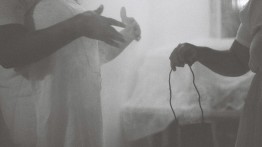Husserl and Spatiality: A Phenomenological Ethnography of Space
Tue, Feb 8, 2022 12pm - Thu, Mar 3, 2022 6pm

Filha-de-santo being incensed. Photo by Tao DuFour
The black and white photographs presented in this exhibition were taken during Tao DuFour’s fieldwork in the city of Salvador, Brazil in the summer of 2010. They are exhibited accompanying the launch of DuFour’s book, Husserl and Spatiality: A Phenomenological Ethnography of Space, published in 2022 by Routledge.
Husserl and Spatiality is an exploration of the phenomenology of space and embodiment, based on the work of Edmund Husserl. Little known in architecture, Husserl’s phenomenology of embodied spatiality established the foundations for the works of later phenomenologists, including Maurice Merleau-Ponty’s well-known phenomenology of perception. Through a detailed study of his posthumously published and unpublished manuscripts on space, DuFour examines the depth and scope of Husserl’s phenomenology of space. The book investigates his analyses of corporeity and the “lived body;” extending to questions of intersubjective, intergenerational, and geo-historical spatial experience; what DuFour terms the “environmentality” of space.
Photographic documentation constitutes an important, although latent, aspect of the book’s descriptive intention and argument. Some of the images on display are reproduced in the book, while many have not been published and are being presented for the first time. They offer photographically mediated insight into the lived experience of Afro-Brazilian religious praxes. Specifically, they document reuniões or “gatherings” that were part of the ritual structure of an Afro-Brazilian religion called Candomblé.
The field notes and sketches exhibited are taken from DuFour’s field notebook, used during his ethnographic fieldwork. They, together with the exhibited photographs, capture significant aspects of lived experience in the field, and indicate the methodological dimensions of DuFour’s fieldwork. They offer insight into the concrete workings of fieldwork, in which writing functioned as a mode of experience. Apart from one of the sketches—the plan of a room—these notes and sketches have not been included in the published book and are being exhibited for the first time.
Tao DuFour, AR'02, is an Assistant Professor at the Department of Architecture at Cornell University, where he is Director of the Landscape and Urban Environmentalities Lab. He holds a BArch from The Cooper Union and obtained his MPhil and PhD in the History and Philosophy of Architecture from the University of Cambridge. DuFour’s extended bio can be viewed here.
For more information about Husserl and Spatiality, please click here.
On view in the Third Floor Hallway Gallery of the Foundation Building. Open to students, faculty, and staff.
Located at 7 East 7th Street, between Third and Fourth Avenues




